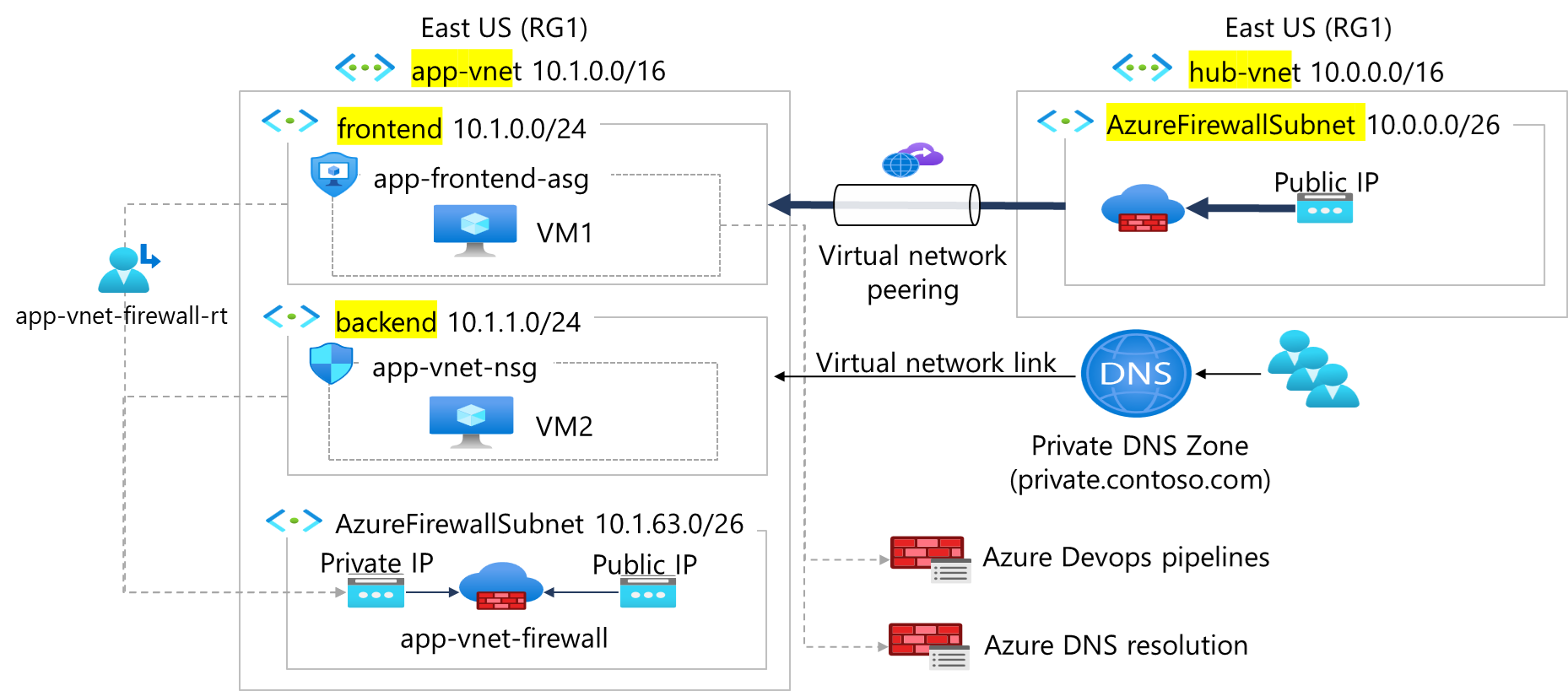Exercise 01: Create and configure virtual networks
Scenario
Your organization is migrating a web-based application to Azure. Your first task is to put in place the virtual networks and subnets. You also need to securely peer the virtual networks. You identify these requirements.
- Two virtual networks are required, app-vnet and hub-vnet. This simulates a hub and spoke network architecture.
- The app-vnet will host the application. This virtual network requires two subnets. The frontend subnet will host the web servers. The backend subnet will host the database servers.
- The hub-vnet only requires a subnet for the firewall.
- The two virtual networks must be able to communicate with each other securely and privately through virtual network peering.
- Both virtual networks should be in the same region.
Skilling tasks
- Create a virtual network.
- Create a subnet.
- Configure vnet peering.
Architecture diagram

Exercise instructions
Note: To complete this lab you will need an Azure subscription with Contributor RBAC role assigned. In this lab, when you are asked to create a resource, for any properties that are not specified, use the default value.
Create hub and spoke virtual networks and subnets
An Azure virtual network enables many types of Azure resources to securely communicate with each other, the internet, and on-premises networks. All Azure resources in a virtual network are deployed into subnets within the virtual network.
-
Sign in to the Azure portal -
https://portal.azure.com. -
Search for and select
Virtual Networks. -
Select + Create and complete the configuration of the app-vnet. This virtual network requires two subnets, frontend and backend.
Property Value Resource group RG1 Virtual network name app-vnetRegion East US IPv4 address space 10.1.0.0/16 Subnet name frontendSubnet address range 10.1.0.0/24 Subnet name backendSubnet address range 10.1.1.0/24 Note:Leave all other settings as their defaults. When finished select “Review + create and then Create.
-
Create the Hub-vnet virtual network configuration. This virtual network has the firewall subnet.
Property Value Resource group RG1 Name hub-vnetRegion East US IPv4 address space 10.0.0.0/16 Subnet name AzureFirewallSubnet Subnet address range 10.0.0.0/26 -
Once the deployments are complete, search for and select your ‘virtual networks`.
-
Verify your virtual networks and subnets were deployed.
Configure a peer relationship between the virtual networks
Virtual network peering enables you to seamlessly connect two or more Virtual Networks in Azure.
-
Search for and select the
app-vnetvirtual network. -
In the Settings blade, select Peerings.
-
+ Add a peering between the two virtual networks.
Property Value Remote peering link name app-vnet-to-hubVirtual network hub-vnetLocal virtual network peering link name hub-to-app-vnetNote: Leave all other settings as their defaults. Select “Add” to create the virtual network peering.
-
Once the deployment completes, verify the Peering status is Connected.
Learn more with online training
- Introduction to Azure Virtual Networks. In this module, you learn how to design and implement Azure networking services. You learn about virtual networks, public and private IPs, DNS, virtual network peering, routing, and Azure Virtual NAT.
Key takeaways
Congratulations on completing the exercise. Here are the main takeaways:
- Azure virtual networks (VNets) provide a secure and isolated network environment for your cloud resources. You can create multiple virtual networks per region per subscription.
- When designing virtual networks make sure the VNet address space (CIDR block) doesn’t overlap with your organization’s other network ranges.
- A subnet is a range of IP addresses in the VNet. You can segment VNets into different size subnets, creating as many subnets as you require for organization and security within the subscription limit. Each subnet must have a unique address range.
- Certain Azure services, such as Azure Firewall, require their own subnet.
- Virtual network peering enables you to seamlessly connect two Azure virtual networks. The virtual networks appear as one for connectivity purposes.